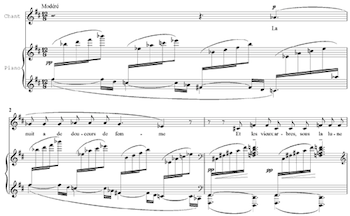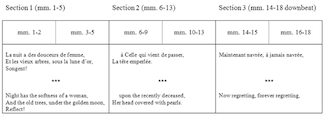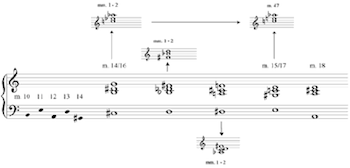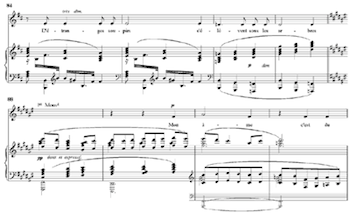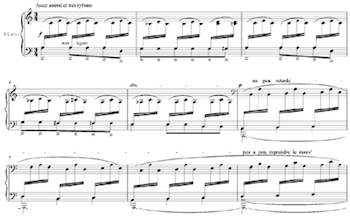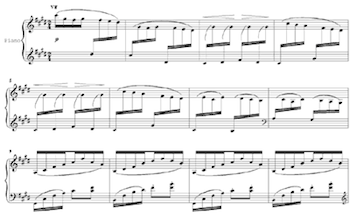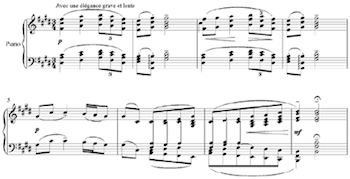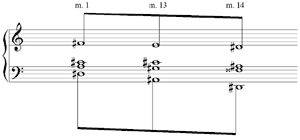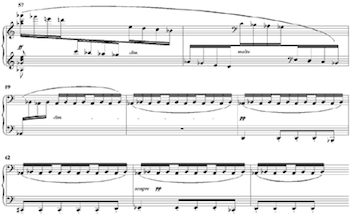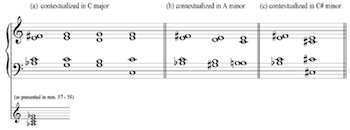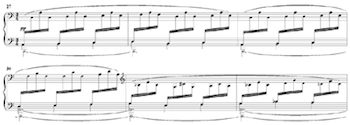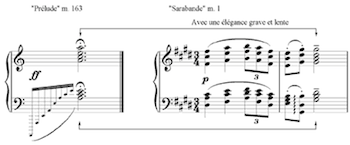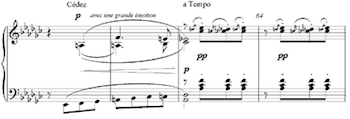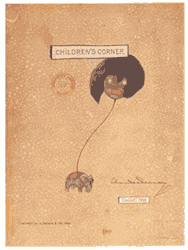Debussy and Recollection: trois aperçu
Gregory J. Marion
KEYWORDS: Debussy, Wagner, recollection, “De rêve,” Pour le piano, “Golliwogg’s Cakewalk”
ABSTRACT: I take the position that Debussy’s treatment of the past is strategically significant in each of the three works considered in the article. Textual and musical concerns mesh in the song “De rêve,” from Proses lyriques, when a state of recall colors the condition of the present. In Pour le piano overt references to Baroque- and Classical-era compositional procedures mask temporal play of an entirely different kind. In “Golliwogg’s Cakewalk,” from Children’s Corner, the allusion to a comedic effect deflects attention from the scathing critique that represents the central message of the work.
Copyright © 2007 Society for Music Theory
Introduction | De rêve | Pour le piano | Golliwog’s Cakewalk | Conclusion | Bibliography
|
I love music passionately, and through my love I have forced myself to |
[1] The topic of recollection in Debussy can be broached in any number of ways. I will explore the means by which recollection assumes strategic significance in portions of “De rêve,” Pour le piano, and “Golliwogg’s [sic] Cakewalk.” One of the central concerns in each of these works is the manner in which Debussy both invokes and impedes communion between old and new compositional practices. The article thus seeks to address Debussy’s positioning of the “present”—his present—as the fashioning of a musical language that is at once backward and forward oriented; said in another way, Debussy’s allusions to aspects of the past—both musical and extra-musical in nature—are responsible for shaping a future based upon generative procedures antithetical to those of the precursors he calls to mind. It may even be that Debussy’s “now” represents an emergence predicated upon remembrance of the past for the very purpose of eclipsing it.
[2] By design the three studies that follow are intended to be independent of one another—the only real common thread among them relates to approach. In valorizing the concept of aperçu I mean to provide glimpses into the imaginative space of what came to fill Debussy’s tabula rasa. Here, the vague term recollection will come to take on a plurality of meanings, including memory: in an intra-psychic sense; as nostalgia; as the “anxiety of influence”; as the allusion to historical musical styles; and as the after-image of a particular historical work (Wagner’s Tristan und Isolde).(2) This tack is reflective of the very backdrop against which Debussy composed, for fin-de-siècle Paris (c. 1890–1914) was a Mecca for interdisciplinary leanings in the arts and the sciences alike. Moreover the era possessed a palpable collective consciousness of the rapid changes that were taking place along cultural, economic, and societal lines—perhaps even to the extent of sponsoring the burgeoning cross-disciplinary focus itself.(3)Interrogations into the nature of time, encountered in virtually all modes of fin de siècle intellectual thought, served as one of the more ubiquitous and hence unifying rubrics of the era.(4) The case is no different for Debussy, where temporal issues are explored via the manner in which the past is accessed, metaphorically brought to life, and subsequently challenged in each of “De rêve,” Pour le piano, and “Golliwogg’s Cakewalk.”
[3] Time consciousness was often coupled with another of the era’s concerns, namely for the spatial, as the two domains are connected in intricate ways. Indeed, as Stephen Kern so eloquently points out, the numbing changes in technology and culture in the 40 years punctuated by the close of World-War I sponsored the institution of new modes of experiencing time and space as witnessed in the many artistic and scientific advances of the period.(5)
[4] Innovation was encountered at every turn: in the world of art Cézanne, Picasso, and van Gogh collectively critiqued perspective, figure-ground relationships, and the expanded role of color and light in painting; Proust, Joyce, and Woolf challenged the temporal flow of novels and the continual shaping and reshaping of the past, the present, and the future by plumbing the depths of an individual’s consciousness; on entirely different fronts there was the conquering of the globe by Peary who reached the North Pole in 1909, and Amundsen the South Pole in 1911; and finally, with one brush-stroke Einstein’s theories of relativity placed before humanity the humbling concept of a dynamic universe.
[5] It is necessary neither to inventory nor to understand the quantity, the scope, or even the pace of change in the Western world during Debussy’s lifetime; it is enough to grasp something of the tenor of the era, and to remember that the dissemination of information—be it of trends in the arts, of regional or world events, or even of political propaganda—was more widespread and more instantaneous than at any earlier point in history. The invention of the telegraph, the telephone, and in interesting ways the cinema, contributed to the simultaneous contraction of the earth and the expansion of the landscape of the mind.(6)
[6] Such, then, was the cultural and creative backdrop for Debussy. And being both in and of the era, Debussy sought to reflect the pitch of its experimental nature, and spoke openly of doing so, as the following familiar 1913 quotation attests:
Is it not our duty
. . . [to] find the symphonic formulae best suited to the audacious discoveries of our modern time, so committed to progress? The century of aeroplanes has a right to a music of its own. Let those who support our art not be left to waste away in the lowest rank of our army of inventors, let them not be outdone by the genius of engineers!(7)
In a compositional sense Debussy answered his own call to duty in numerous ways, and the retooling of temporal and spatial concerns was principal among them.(8) Here that retooling is intimately linked to the notion of recollection.
[7] Although an oversimplification of a complex issue, much of what might be deemed the unfolding of the drama in a musical composition dating from the common-practice era does so in tandem with the unidirectional flow of the timeline. As a result, the manner in which earlier and later events inform one another in a piece, say, by Haydn—while not without consequence—is inscribed in predictable ways. Even the powerful notion of “surprise” in tonal repertoires is often attributable to temporary challenges issued against, but never replacing, the orderly move toward the inevitable.(9) All of this was to change with Debussy, who came to question the very impact that “earlier” and “later” might hold in a musical sense, and in so doing, uniquely positioned what accrual of information was to mean in every one of his works.
***
[8] “De rêve” is the lead song in the cycle Proses lyriques (1892–95).(10) The fact that we have recourse to the interaction of textual and musical concerns makes this piece ideal for an initial pass at recollection in Debussy’s music. What is more, Debussy himself penned both the poetry and the music of the cycle.(11)
[9]
I will limit discussion here primarily to the opening of “De rêve.” The complete
poem and a reproduction of measures 1–18, however, are provided below.(12)
|
Figure 1. “De rêve,” Debussy’s poem and its English translation (click to enlarge) |
Example 1. “De rêve,” measures 1–18 (click to enlarge and see the rest) |
Lines one through five of the poem correspond to measures 1–18 of the music. In these opening measures the ever-changing musical surface features the commingling of non-diatonic and diatonic passages coupled with shifts in rhythm, tempo and dynamics, all of which highlights a phasing between two musical traditions, the present (Debussy’s present) and the past, and the shift among realms is underscored textually.(13) The non-diatonic framework from the opening of the piece gives over (in measure 6 and following) to a tonal span initially suggestive of B minor, and with it comes Debussy’s textual/musical shift into a recollected past. Before the end of the excerpt, chromaticism nearly undermines the tonal orientation, but ultimately abates with the arrival of the A major chord in measure 18. Yet the seemingly disparate soundscapes represent a tightly knit structure.
[10] Figure 2 proposes a three-sectioned segmentation of measures 1–18. Here is the text:
In section 1, a narrative sequence leads from a metonymical relationship to a concluding injunction.(14) In the former, an attribute of womanhood (softness) stands for night and all that it entails; in the latter, the injunction “Songent!” [Reflect!] breaks the effemeral hold of the first two lines and is multiply directed—toward the personified trees, the narrator, and in equal measure to the poem’s reader. In section 2 descriptive prose replaces the earlier figurative language and introduces a temporal change to a state of recall. The image of “the recently deceased/Her head covered with pearls” is unleashed from memory by the initial word of line 3, “Songent!” [Reflect!] The recollection proves to be short-lived, for it is interrupted in section 3 by another swerve. In “Maintenant navrée, à jamais navrée” [Now regretting, forever regretting] “Maintenant” acts in the same manner as “Songent!” had before it, triggering the move from one temporal state to another, and by so doing establishes the correct orientation of a regret.(15)
[11] The musical setting meshes with the temporal shifts in the text. For instance, B minor is in play over much of measures 6–13; but its hold is equivocal, for the tonal language of the passage captures the spirit of days past, but stops short of assimilating fundamental traits of the common-practice period, such as complete deference to the gravitational pull of a single tonic. Metaphorically, something remains of the earlier time, and yet it is not wholly available to a present whose connection to it is through recollection. It is with these curious issues in mind that we retreat to the outset of “De rêve.”
[12] Much is transpiring in the opening two measures, where at least three
distinct arpeggiating strands interact; the lower edge of the piano’s gesture
unfolds the familiar Debussyan sound of a harmonically non-functional French
augmented-sixth chord; and at the upper edge, the piano’s right hand toggles
between an augmented triad—whose root, for agogic and other reasons (see below),
is F![]() —and
an A-flat major chord. The voice, setting the initial line of the poem,
underscores pitches of the piano’s upper arpeggios. The
—and
an A-flat major chord. The voice, setting the initial line of the poem,
underscores pitches of the piano’s upper arpeggios. The ![]() in the course of measures 1–3.(18) But once so altered, the opening sonority is recast in a tonal role and when D
natural returns in measure 4 it functions within the context of an intensified
functional dominant harmony, leading (melodically) through an accented passing
tone, and on to scale degree one of B minor in measure 6. The past emerges from the
future, or said in a different way the past is culled from an individual’s
memory recalling a bygone era. And as with all such recollections, that which is
invoked takes shape as an imperfect image of what actually transpired in another
time, and at another locale.(19)
in the course of measures 1–3.(18) But once so altered, the opening sonority is recast in a tonal role and when D
natural returns in measure 4 it functions within the context of an intensified
functional dominant harmony, leading (melodically) through an accented passing
tone, and on to scale degree one of B minor in measure 6. The past emerges from the
future, or said in a different way the past is culled from an individual’s
memory recalling a bygone era. And as with all such recollections, that which is
invoked takes shape as an imperfect image of what actually transpired in another
time, and at another locale.(19)
[13] The effect of the opening is made all the more powerful by the fact that shifting between present and past is a recurring feature of the song, and on each occasion is predicated upon a similar connection between textual signal words and the move from one tonal syntax to another.(20)
Example 3. “De rêve,” contextualizing thread two, measures 1–18
(click to enlarge)
Example 4. “De rêve,” an interpretation of measures 14–15 / 16–18
(click to enlarge)
Example 5. “De rêve,” measures 84–99
(click to enlarge and see the rest)
[14] Another of the three threads from the opening of “De rêve” unfolds in similar fashion. While the arpeggiated A-flat major chord is a subsidiary event in measures 1–2, it comes to assume a dominant role in establishing the swerve to A major—the key area that takes hold in measure 18 and beyond. Example 3 will help to illustrate.
[15]
In stage one of the contextualization 5–6 technique converts root and fifth of
the A-flat major chord into root and third of what in stage two becomes the
functional V5# / A major. C is retained as common tone in each of the earlier
sonorities, but with the tacit understanding that the pitch functions as B![]() in
the progression to C
in
the progression to C![]() in measure 18. Later in the song (m. 47), the sonority here
read as altered V/A returns as an augmented chord in the varied repetition of
the head motive.
in measure 18. Later in the song (m. 47), the sonority here
read as altered V/A returns as an augmented chord in the varied repetition of
the head motive.
[16] The process outlined above is akin to the earlier move to B minor. But a fascinating and edifying progression occurs just in advance of measure 18 and the arrival of A major; at the point of maximum dissonance in terms of music and poetry (measures 14–15, repeated in measures 16–17), allusional reference is made to each of the sonorities of measures 1–2. Example 4 will help to illustrate. The series of augmented chords in measures 14–17 emerges at the tail end of a sequence of descending fifths (measures 10–14). These same augmented chords either replicate, or—in a manner consistent with Lewin’s “law of the nearest way”(21)—express slick familial relationships with the three principal sonorities from the opening measures of “De rêve”; the text in measures 14–17 is a present tense lament of a lost past: “Maintenant navrée, a jamais navrée” [Now regretting, forever regretting].
[17]
A corollary to the 6–5 voice-leading motions expressed at the opening of “De
rêve” effects a link between the song’s initial and its concluding measures. Example 5 reproduces measures 84–99.
The temporal orientation in the text changes from the immediate present to a
distant past populated by Grail knights, the latter reflective of the realm
wherein the protagonist’s soul ultimately resides; the shift is triggered by
“D’étranger soupirs” [Strange sighs] issuing from an otherworldly “ancient
dream.” This inward turn of emotions is accompanied by the inward resolution of
the B–F tritone (registrally accented in the left-hand piano gesture across
measures 84–87). F, the later event, slides to F![]() in measure 88, and B (prolonged in measures
84–87) is ultimately transferred into an inner voice, and moves to A
in measure 88, and B (prolonged in measures
84–87) is ultimately transferred into an inner voice, and moves to A![]() in measure
88. The tonal focus on F
in measure
88. The tonal focus on F![]() major from measure 88 through to the conclusion of the song
effectively provides another context for the 6–5 voice leading procedure
encountered in measures 1–3 (refer to Example 2), for on textual grounds it is
plausible to interpret each of the two F
major from measure 88 through to the conclusion of the song
effectively provides another context for the 6–5 voice leading procedure
encountered in measures 1–3 (refer to Example 2), for on textual grounds it is
plausible to interpret each of the two F![]() -major sonorities, the one in measure 3, and
the one here, as consequent to the antecedent represented by the F
-major sonorities, the one in measure 3, and
the one here, as consequent to the antecedent represented by the F![]() augmented
triad in measures 1–2.(22)
augmented
triad in measures 1–2.(22)
[18] The foregoing argument is further substantiated from a performance standpoint, for it is telling to note that the projection of the three distinct accompanimental strata in measures 88–91 cannot be effected as written: a subtle fissure between measures 87–88 prohibits the lowest of the three stratum from operating in sync with the other two, and in a metaphorical sense, the bass line remains in the temporal domain of the preceding phrase. It takes pronouncement of the textual message in the vocal line following measure 89—“Mon âme c’est du rêve ancient qui t’étrient!” [My soul is of an ancient dream embracing you]—to redress the schism between strata, for once the textual message has been uttered, all participants in the setting again operate in the same temporal dimension: coming together, as it were, in the world of dream, memory, and recollection. In the end the present merges with the past in a reformational sense, without ever capitulating to that which cannot be recreated.
***
[19] Quite a different sense of recollection is encountered in Pour le piano (1901) than is the case in “De rêve.” In Pour le piano a historically- and a self-aware Debussy(23) come together and openly engage with earlier traditions through overt references to Baroque genres expressed in the titles of each of the Suite’s movements: “Prélude,” “Sarabande” and “Toccata.”(24) What transpires in the work, however, is an interrogation of the musical past spawning a present that Debussy claims for himself. And in this regard the Suite is manifestly representative of Debussy’s lifelong struggle with that which Harold Bloom, in different contexts, has described as the crippling awareness of what it is to be a late-comer—one forced to establish ones own place in history.(25)
[20] From a musical perspective, engagement with the past begins in the initial measures of the “Prélude.” Example 6 reproduces the work’s opening 27 measures. In the introduction (measures 1–6 (downbeat)) the melody is in the bass voice, and features a descending arpeggiation through the A minor chord: the pitch A at the outset giving over to E and C in measure 5, before reaching low A in measure 6. Tonally, registrally, and gesturally, this bass-voice melody would not be out of place in any number of compositions dating from the 18th century.(26) The Baroque seal is all the more apparent in the descending tetrachord expressed in the bass, where A is prolonged in measures 1–3, G and F in measure 4, and E in measure 5. The complete setting of these same measures, however, witnesses Debussy in contact with old-world sensibilities in the planing effects (hereafter “chordal parallelism”) heard in measures 2 and 4, as well as the whole-tone harmonizations entering at the end of measure 4 and extending through measure 5.(27)
[21] The stage, as it were, has been set, and from an aesthetic point of view the remainder of the “Prélude” represents a clever study in the juxtaposition of two temporal realities separated by nearly 150 years, for at certain moments one reality dominates, while at others the two realities collide: the introduction yields to a span of music (measures 6 -10) which is decidedly of an earlier era; but as the excerpt in Example 6 continues the present, Debussy’s present, begins more-and-more to assert itself, until the past is modernized to such an extent that it no longer holds sway. A telling moment occurs when the perpetual mobile of the steady sixteenth-note rhythm is interrupted by silence (on the downbeat of measure 26) before heading “back to the Baroque” in measure 27.
[22] I will not provide a catalogue of the “Prélude’s” gestural affinities with various past compositional procedures. Suffice it to say that the events thus far encountered are restricted neither to these initial measures, nor to the opening movement of the Suite. In point of fact recollection of the past serves as a touchstone for the future throughout Pour le piano. Example 7 reproduces the opening 33 measures of the final movement “Toccata.” Measures 1–8 subtly juxtapose syntaxes expressive of new and old compositional practices. The effect is established in measure 1, where the absence of the pitch E casts the first five sixteenth notes in a pentatonic context (the new).(28) But the larger sweep of the measure subsumes the pentatonic effect within a diatonic framework (the old) predicated upon an initial leap from down to and a descending scalar motion from to . The alternation between pentatonicism and diatonicism is most noticeable in measures 3–4 and measures 5–6, but from measure 6 onward the earlier practice comes to dominate, and at that with Baroque élan.(29) The scene changes abruptly in measures 9–12, where a modal flavor takes hold, and forward motion stalls. In short, measures 9–12 represent an attempt to establish a present from the past. A short-lived Classical-era vignette appears in measures 13–20. It is based upon a descending major scale featuring a bright tone, and the establishment of a light mood—all of which is supplanted after measure 21, and from m. 26 a near daemonic sequential passage takes hold, a passage inconceivable in the days of Bach or Beethoven—or perhaps better, in the days of Couperin or Berlioz.(30)
[23] To review, the “Prélude” is preludial in its declaration that recollection will dominate the compositional landscape of Pour le piano; the “Toccata,” too, however, measures up to its name, being very much in the nature of an improvisation. In many ways, it is the middle-movement “Sarabande” that is the most difficult to characterize: for although in terms of tempo, rhythmic design, and transparency of form the movement is true to the French Baroque conceit that a sarabande must emulate a slow menuet, its harmonic palette is more consistently progressive than that of either the “Prélude” or the “Toccata.”
[24] Example 8 reproduces the opening 22 measures of the “Sarabande."
“Avec une élégance grave et lente” to use the composer’s words, the
surface-level gestures and voice-leading procedures of the passage are: strongly
goal oriented toward C![]() in measure 22; decidedly modal in character; and replete with
chordal parallelisms. The descending tetrachord in the bass beginning in measure 19
(C
in measure 22; decidedly modal in character; and replete with
chordal parallelisms. The descending tetrachord in the bass beginning in measure 19
(C![]() –B–A–G
–B–A–G![]() ) recalls the similar Baroque thumbprint employed in the
first-movement “Prélude,” as does the bass-line arpeggiation of the tonic chord
in measures 19–22 (C
) recalls the similar Baroque thumbprint employed in the
first-movement “Prélude,” as does the bass-line arpeggiation of the tonic chord
in measures 19–22 (C![]() , downbeat of measure 19, giving over to G
, downbeat of measure 19, giving over to G![]() on the downbeat of measure
20, with E entering in measure 21, and C
on the downbeat of measure
20, with E entering in measure 21, and C![]() in measure 22).
in measure 22).
[25] Recollection, however, saturates the complete passage on another count and signals Debussy’s grappling with a much more immediate past, for the choice of a half-diminished seventh as the movement’s initial vertical sonority is provocative: without meaning to overstate the issue, marked usage of half-diminished seventh sonorities (post 1865) had the potential to invoke the ghost of Wagner, and when interrogating Debussy’s repertoire, one must remain sensitive to the fact that that ghost was never fully exorcised. But a single sighting does not an association make, and especially given Debussy’s complex and shifting attitude toward Wagner.(31) Yet there are subtle ways in which Wagner, if not embraced in the larger scope of Pour le piano, does provide a frame of reference for Debussy in his, Debussy’s, promotion of a personal identity.(32)
[26]
I contend that the appearance of half-diminished seventh sonorities at critical
junctures in the “Sarabande” is anything but serendipitous. Roy Howat’s
observation that the first and second chords in the original version of the
“Sarabande” are Tristan laden helps to substantiate my point, for chord two in
the earlier version of the piece contains ![]() , and the
quality of the resultant sonority is half-diminished.(33)
, and the
quality of the resultant sonority is half-diminished.(33)
[27] Refer again to Example 8, and in particular to the event encountered on
the downbeat of measure 13. In a Wagnerian context the sonority might well have
served as pre-dominant harmony in the key of D, for such would be the fate of a
bona fide Tristan chord with A![]() as its bass and C
as its bass and C![]() as its uppermost note. But the chord on the downbeat of measure 13 does not continue
to an A7 sonority. Instead, locally, the Debussy harmony is an altered dominant
progressing to I of D
as its uppermost note. But the chord on the downbeat of measure 13 does not continue
to an A7 sonority. Instead, locally, the Debussy harmony is an altered dominant
progressing to I of D![]() for the cadence in measure 14; what is more, the cadence itself qualifies the opening
measures of the movement, as Example 9 will help to illustrate. In the reading, the D
for the cadence in measure 14; what is more, the cadence itself qualifies the opening
measures of the movement, as Example 9 will help to illustrate. In the reading, the D![]() half-diminished seventh sonority of measure 1 is interpreted
as incipient tonic harmony prefiguring the cadential gesture in measures 13–14.
Poetically stated, the initial harmony refuses to function as a Tristan chord
would: in this case—given the bass note D
half-diminished seventh sonority of measure 1 is interpreted
as incipient tonic harmony prefiguring the cadential gesture in measures 13–14.
Poetically stated, the initial harmony refuses to function as a Tristan chord
would: in this case—given the bass note D![]() —as a preparatory event for V / G.(34)
But
in terms of goal directedness, the opening of the “Sarabande” is unsettled on
other counts. The return of the initial half-diminished seventh chord at the end
of measure 1, coupled with the bass motion by descending perfect fifth (D
—as a preparatory event for V / G.(34)
But
in terms of goal directedness, the opening of the “Sarabande” is unsettled on
other counts. The return of the initial half-diminished seventh chord at the end
of measure 1, coupled with the bass motion by descending perfect fifth (D![]() –G
–G![]() ), is
suggestive of a G
), is
suggestive of a G![]() phrygian setting. The reading is made problematic, however,
by the strong-beat incursion of the E major sonority on the downbeat of measure 2,
which has the effect of separating the D
phrygian setting. The reading is made problematic, however,
by the strong-beat incursion of the E major sonority on the downbeat of measure 2,
which has the effect of separating the D![]() from the G
from the G![]() , and thus denies any sense
of definitive cadence. Further, attention to the motion by parallel tenths
between the outer voices of measure 1 supports a more tonally focused orientation
with the E major chord of measure 2 as tonic harmony; that is to say, the chordal
parallelisms of measure 1 surreptitiously project an extended linearized V6/5 of E,
which moves to I / E on the downbeat of measure 2.
, and thus denies any sense
of definitive cadence. Further, attention to the motion by parallel tenths
between the outer voices of measure 1 supports a more tonally focused orientation
with the E major chord of measure 2 as tonic harmony; that is to say, the chordal
parallelisms of measure 1 surreptitiously project an extended linearized V6/5 of E,
which moves to I / E on the downbeat of measure 2.
[28] The point is that ambivalence or even antagonism toward a single governing
stability is de rigueur from the head of the “Sarabande.”(35)
In fact, the
suggestion that D![]() represents tonic in measure 14 is only true in a fleeting sense,
for the ultimate function of D
represents tonic in measure 14 is only true in a fleeting sense,
for the ultimate function of D![]() (and of chordal events predicated upon it) is
more properly regarded as supertonic of C
(and of chordal events predicated upon it) is
more properly regarded as supertonic of C![]() —the goal both of measures 1–22, and of
the movement as a whole. This last statement takes on greater significance via
accrual of the following information: the middleground bass line across measures 1–14 arpeggiates a G
—the goal both of measures 1–22, and of
the movement as a whole. This last statement takes on greater significance via
accrual of the following information: the middleground bass line across measures 1–14 arpeggiates a G![]() minor triad—G
minor triad—G![]() in measures 1–4 giving over to B in measure 8 and D
in measures 1–4 giving over to B in measure 8 and D![]() in measure 14.
in measure 14.
[29] Wedged between the tonally schizophrenic “Prélude” and the only slightly more stable “Toccata,” the “Sarabande” links the outer movements together by redirecting the tonal orientation encountered in the “Prélude” toward a different ultimate goal at the end of the Suite. All of this is part of a larger story, however, for additional inter-connective webs unify the three movements of Pour le piano and invoke further Wagnerian recollections in the form of veiled allusions.
[30] The “Prélude” features a conflict between two conventionally related tonal centers: A minor and C major. And although A minor ultimately prevails, the outcome is by no means a foregone conclusion, as C major remains a prominent force in the movement as late as the fourth-to-last measure. Recognition of the shifting between A and C in the “Prélude,” however, is significant with respect to Wagnerian recollection as an undercurrent in Pour le piano, for A and C are the two tonal regions pitted against one another early on in Tristan und Isolde.(36) And yet while at the deepest structural level the tonal struggle in the two preludes—Wagner’s and Debussy’s—is identical, the surface-level gestures of the earlier work have little bearing on those of the later: in a word, Debussy carefully shrouds the evocation of his precursor. What is more, the shrouding itself may well represent a cleansing act.(37)
Example 10. “Prélude,” partitions of the whole-tone scales
(click to enlarge)
Example 11. “Prélude,” measures 57–64
(click to enlarge)
Example 12. The sonority of measures 57–58 in the “Prélude,” contextualized
(click to enlarge)
Example 13. “Prélude,” measures 27–47
(click to enlarge and see the rest)
Example 14. Pour le piano, inter-movement connections
(click to enlarge and see the rest)
[31]
A significant portion of Debussy’s “Prélude” is based upon either one or the
other of the two whole-tone scales (see Example 10).
For instance, measures 57–96 (or fully one quarter of the movement) derive entirely
from the whole-tone scales outlined in Examples 10(a) and 10(b).(38) Although
potentially amorphous events given the regularity of their intervallic
structuring, Debussy carefully partitions the two scales in ways that allow
various sonorities to acquire dominant functionality at particular moments over
the course of the passage. V / A and V / C dominate, underscoring the principal
keys of the “Prélude” and maintaining the Wagner-based recollection.(39)
But a vivid reference to another dominant chord exists in the context of the
whole-tone scale encountered in the passage excerpted in Example 11.
The sonority at the head of the passage carries with it multiple functions:
locally it represents altered
![]() VI of C; when it returns in measure 71 (and following)
the sonority is increasingly associated with A minor (A flat in the bass
equaling the enharmonically respelled leading tone of A); a third meaning,
however, reflects an inter-movemental tonal bond between measures 57–58 in the
“Prélude” and both the “Sarabande” and the “Toccata,” as these two measures of
the “Prélude” forecast C
VI of C; when it returns in measure 71 (and following)
the sonority is increasingly associated with A minor (A flat in the bass
equaling the enharmonically respelled leading tone of A); a third meaning,
however, reflects an inter-movemental tonal bond between measures 57–58 in the
“Prélude” and both the “Sarabande” and the “Toccata,” as these two measures of
the “Prélude” forecast C![]() , the ultimate key of the later movements, in the guise
of its V. Example 12 models the three progressions in which the
whole-tone sonority of measures 57–58 participates, in turn reflecting the move to
I / C major, I / A minor, and I / C
, the ultimate key of the later movements, in the guise
of its V. Example 12 models the three progressions in which the
whole-tone sonority of measures 57–58 participates, in turn reflecting the move to
I / C major, I / A minor, and I / C![]() minor.
minor.
[32]
Additional Wagnerian recollections exist in Pour le piano, and at that embrace
both intra- and inter-movemental concerns. Refer to Example 13.
These measures again lay bare the opposition between the principal tonal regions
of the Suite’s first movement, but they also serve as a conduit enabling
communication with significant moments in the Tristan “Prelude.” Beginning as a
repetition of measure 6 and ff., the material in Example 13 initially unfolds in A
minor. By measure 43, however, A minor has given way to C major. In fact, measures 43–47
prolong C by means of an underlying I–V–I harmonic progression; and yet
Debussy’s distortion of the tonal past is unmistakable in these later measures,
where whole-tone harmonization of the bass line’s descending linear tetrachord
accounts for the vertical events above B![]() in measure 44, A
in measure 44, A![]() in measure 45, and above F
in measure 45, and above F![]() in
m. 46 (the latter of which is contextualized as an altered secondary dominant
chord (V / G)). In fact, both whole-tone scales are in play in measures 43–47—the
consonant skips by perfect 4th in the bass at the end of measures 43, 44, and 45
reference the two symmetrical scales: C–B
in
m. 46 (the latter of which is contextualized as an altered secondary dominant
chord (V / G)). In fact, both whole-tone scales are in play in measures 43–47—the
consonant skips by perfect 4th in the bass at the end of measures 43, 44, and 45
reference the two symmetrical scales: C–B![]() –A
–A![]() from the one are coupled with
G–F–E
from the one are coupled with
G–F–E![]() from the other.
from the other.
[33] In measures 41–42 Debussy signals that C major is at hand. Prior to measure 41, the passage in Example 13 had been a near verbatim repetition of the “Prélude’s” opening—the ultimate goal of which was the return of A minor in measure 27. But in measure 41, the direct repetitions of the stepwise ascent from F to B—linearizing the two most active pitches in V7 of C—combine with the F major chord articulated on each beat in measures 41 and 42, and the appearance of the F major chord is illuminating; while containing both A and C, the chord never-the-less separates the two principal tonal regions of the “Prélude,” and does so in a manner analogous to the procedure employed by Wagner at the first heightened cadential moment in Tristan. The reciprocal nature accorded F in the Wagner “Prelude” (simultaneously VI / A and IV / C) is thus appropriated as part of Debussy’s imaginative space, and made his own in Pour le piano—in a trenchant sense, Wagner is recalled here so as to be surmounted.(40)
[34]
It is in the light of the triple recollection of Wagner—in the Teutonic
composer’s “suggestions” of A minor and C major plus his “deflective” F—that we
return to the sonority encountered at the opening of the second movement of the
Suite. I have already established that in an intra-movemental sense the D![]() half-diminished seventh sonority in measure 1 of the “Sarabande” carries multiple
functions, at once: participating in a G
half-diminished seventh sonority in measure 1 of the “Sarabande” carries multiple
functions, at once: participating in a G![]() phrygian modal progression;
representing incipient tonic chord in D
phrygian modal progression;
representing incipient tonic chord in D![]() major; and serving as pre-dominant
chord in C
major; and serving as pre-dominant
chord in C![]() minor. While perhaps not altogether mutually-exclusive, it is the
latter of these interpretations that proves to be the more far-reaching with
respect to the Suite as a whole, for C
minor. While perhaps not altogether mutually-exclusive, it is the
latter of these interpretations that proves to be the more far-reaching with
respect to the Suite as a whole, for C![]() is the ultimate key in the “Sarabande”
and in the ensuing “Toccata.” But in typical Debussyan fashion, the D
is the ultimate key in the “Sarabande”
and in the ensuing “Toccata.” But in typical Debussyan fashion, the D![]() half-diminished seventh of measure 1 comprises a third and altogether different
function: it provides a back-reference to the earlier “Prélude.” Example 14 will help to illustrate.
By juxtaposing the ending of the “Prélude” and the beginning of the “Sarabande,”
Example 14(a) draws attention to registral connections among contiguous moments
in the two movements. Such a device frequently appears in Debussy’s
multi-movement compositions, and assumes the role of a reinterpretive swerve.(41)
More insightful with respect to the Wagnerian argument, however, is the
anachronistic join proposed in Example 14(b). In it, the D
half-diminished seventh of measure 1 comprises a third and altogether different
function: it provides a back-reference to the earlier “Prélude.” Example 14 will help to illustrate.
By juxtaposing the ending of the “Prélude” and the beginning of the “Sarabande,”
Example 14(a) draws attention to registral connections among contiguous moments
in the two movements. Such a device frequently appears in Debussy’s
multi-movement compositions, and assumes the role of a reinterpretive swerve.(41)
More insightful with respect to the Wagnerian argument, however, is the
anachronistic join proposed in Example 14(b). In it, the D![]() half-diminished
seventh sonority of the opening of the “Sarabande” is regarded in a manner akin
to that of an authentic Tristan chord, progressing to the dominant of G in measure 46
of the “Prélude,” which in its turn moves to V7 and I of C in measure 47.(42)
half-diminished
seventh sonority of the opening of the “Sarabande” is regarded in a manner akin
to that of an authentic Tristan chord, progressing to the dominant of G in measure 46
of the “Prélude,” which in its turn moves to V7 and I of C in measure 47.(42)
[35]
The reading in Example 14(b) is predicated upon the fact that although later in
terms of its temporal positioning, the D![]() half-diminished seventh chord of the
“Sarabande” conceptually precedes that which actually occurs earlier in the
Suite: motion to the heightened G7 in the “Prélude” en route to I / C.(43) But more
significantly, the reading establishes yet another role for the opening of the
“Sarabande”: the movement’s initial half-diminished seventh chord, pointing
forward and backward in time, represents a profoundly pivotal moment in
Pour le
piano, a moment upon which the whole of the drama turns. And from the vantage
point of the whole, the “Sarabande” recalls the past (i.e. the “Prélude”), and
projects into the future (the “Toccata”) in an overt sense via association with
Baroque genres, and subtly, through the secret nexus of specific Wagnerian
affiliations. In Pour le piano, then, the distant and the immediate past are
submerged under the weight of Debussy’s fashioning of the present.
half-diminished seventh chord of the
“Sarabande” conceptually precedes that which actually occurs earlier in the
Suite: motion to the heightened G7 in the “Prélude” en route to I / C.(43) But more
significantly, the reading establishes yet another role for the opening of the
“Sarabande”: the movement’s initial half-diminished seventh chord, pointing
forward and backward in time, represents a profoundly pivotal moment in
Pour le
piano, a moment upon which the whole of the drama turns. And from the vantage
point of the whole, the “Sarabande” recalls the past (i.e. the “Prélude”), and
projects into the future (the “Toccata”) in an overt sense via association with
Baroque genres, and subtly, through the secret nexus of specific Wagnerian
affiliations. In Pour le piano, then, the distant and the immediate past are
submerged under the weight of Debussy’s fashioning of the present.
***
[36] A third distinct approach to recollection and its role in positioning the past appears in one of Debussy’s most direct Wagnerian summonings, namely in “Golliwogg’s [sic] Cakewalk,” the last of the six piano miniatures in Debussy’s 1908 collection entitled Children’s Corner.
[37] At first blush, it may appear as though the central project of “Golliwogg’s Cakewalk” is the intermingling of “low” and “high” art-forms within a single work—something quite common in Debussy’s Paris:(44) the low here derives from the use of a dance form associated with ragtime music and early African-American culture, and is further reflected in the title’s reference to a black minstrel doll and veritable racist symbol; the high, on the other hand, devolves from the parody of what are arguably the most recognizable measures from any of Wagner’s operas—namely, the opening passage of Tristan und Isolde appropriated in the middle section of the ABA structure of “Golliwogg’s Cakewalk.” Were the case to be as simple as this, irony might well be deemed the dominant trope for the piece, and would contextualize the Wagnerian reference in a satirical light. But reflection on the mix of musical detail and extra-musical allusion leads to a much bleaker assessment, one with tragedy at its core.
***
[38] I must make a digression at this point, for in referring to irony, satire, and tragedy (and earlier in the article to metonymy), I am drawing on the work of the cultural historian Hayden White (1973) and less directly on that of the literary critic Northrop Frye (1957). White’s argument is involved, and runs to levels much deeper than it will be necessary to document here. In fact, I rely almost entirely upon two exceptional glosses of White in web articles by Joshua Walker (2002), and Hans Kellner (Kellner 1997).(45)
[39] In Walker’s words, White’s starting point is that “all historical explanations are rhetorical and poetic by nature.” They represent fictions that project particular ideological stances (anarchist, radical, conservative, liberal), expressed through the choice of certain modes of emplotment adopted in the telling of the story (romance, tragedy, comedy, or satire), and are reflective of particular apprehensions of historical fields (formist, mechanist, organicist, or contextualist), affiliated with one or more of four dominant tropes (metaphor, metonymy, synecdoche, or irony).
[40] My concern here is quite limited, for I will only assess aspects of the explanatory strategies adopted by a work’s author—in this case Debussy—as a means of presenting a premise in the guise of historical fact. A portion of Walker’s summation chart appears below—the portion concerned with the affinity between dominant trope, its function, the mode of emplotment signified by the use of a particular trope, and the associated notion that there is an ideal moment in time where the author projects “all is as it should be.”
[41] Each of the dominant tropes reflects a particular strategy with respect to the relationship of parts to whole. With metaphor, a direct one-to-one connection exists between the subject and the object, expressed algebraically as A = B. By contrast, metonymy establishes a part-to-whole relationship wherein an attribute of the subject is made to stand for the subject itself—the locus classicus is reflected in the statement “he is all heart.” From representation (the function of metaphor is to represent), metonymy moves to the level of reduction. Representation is an unattainable idealization, and thus metaphor must draw upon romance as a mode of emplotment while looking toward a past wherein A is said truly to have been equal to B—something that is no longer possible; such idealism is anathema in metonymy, which takes as its default tragedy. And yet with metonymy, the near future holds promise, for upon its arrival the inherent flaws of the past and of the present will be overcome. In the integrative function of synecdoche, an external attribute is said to represent the thing itself, giving rise to identifications such as “Whitehouse” for “Presidency,” or more playfully, perhaps, “cheesehead” for “Wisconsonite”—the latter proposed here both to reflect the comic nature of the statement (synechdoche’s mode of emplotment is comedy), and as a means of valorizing the present (the moment in time with which the mode is most concerned). By contrast, irony looks to negate as a means of transcending that which is other than it could or should be. The author’s adoption of a satirical tone, strategic or otherwise, in part at least speaks to the belief that the present holds little promise: nirvana lies out of reach in the distant and unforeseeable future.(46)
***
[42] Returning to the Debussy let me start by considering the possibility of humor, either comical or satirical—the distinction between the two need not concern us for the moment. The very juxtaposition of Wagner, or better, the juxtaposition of the aural experience and the visual spectacle encountered at Bayreuth (Wagner’s exclusive shrine to opera), and at the opposite end of the spectrum the sights and the sounds of the music hall on a Saturday night, would have brought a smile to the face of any number of Debussy’s contemporaries quick enough to catch the association; and the association is unmistakable in “Golliwogg’s Cakewalk.” But conspicuous in its absence from the middle portion of Debussy’s piano piece—where the opera’s initial cello line is clearly placed on display—is an authentic presentation of the very harmony that continues to engender much critical thought even today, nearly 150 years after its Wagnerian contextualization: the “Tristan” chord itself.(47) Example 15 reproduces measures 61–64 of “Golliwogg’s Cakewalk,” where Debussy summons from memory (viz. recalls) the melody of the opening of Wagner’s opera. A veiled reference to the “Tristan” chord is heard in measure 63 of “Golliwogg’s Cakewalk,” beginning with the after-beat accompaniment to the melody of the previous measure. But a registral fracture occurs between the tune begun in measure 61 and the stock-in-trade cakewalk figure of measure 63 (the backdrop for the chord), and thus the Wagnerian melody and its principal harmonic affiliate are disassociated from one another. What is more, by rearranging the order of pitches in the sonority in measure 63 of “Golliwogg’s Cakewalk” from their canonical placement as initially experienced in Wagner’s opera, Debussy distorts the “Tristan” chord. In Example 15, for instance, Debussy embeds Wagner’s bass note F in an inner voice. The imperfect recollection of Wagner in the middle portion of “Golliwogg’s Cakewalk,” then, poses as many questions as it answers.
Example 16. “Golliwogg’s Cakewalk,” measures 1–4 and measures 10–13
(click to enlarge and see the rest)
[43] A more powerful citation of the “Tristan” chord does, however, occur much
earlier in “Golliwogg’s Cakewalk,” namely, in the very opening measures of the
work (see Example 16).
The “Tristan” chord unfolds a number of times over the course of measures 1–4, but it
is projected as a linear event, which is anathema to the sonority’s
initial use at the opening of the opera.(48)
Beginning in measure 2, left- and right-hand octave doublings cascade downward
through the four pitches of the “Tristan” chord while bringing about an overall
crescendo in the dynamic level. In measures 10 and 11 the “Tristan” chord is rendered
vertically, its natural state from the head of the “Prelude” (see the boxed
material in Example 16(b)), and Wagner’s bass note F is restored in its proper
register. It is at the opening of the cakewalk, then, and not in its middle section, that Debussy most closely evokes the memory of his precursor. And yet even here, things are
veiled, for Debussy’s close positioning of the chord places Wagner’s upper pitch
G![]() in the tenor register. Further, it and Wagner’s B natural are enharmonically
respelled (as A flat and C flat, respectively). Real authenticity, it would
seem, is just beyond reach.
in the tenor register. Further, it and Wagner’s B natural are enharmonically
respelled (as A flat and C flat, respectively). Real authenticity, it would
seem, is just beyond reach.
[44] And now for the primary point: in each of Examples 16(a) and 16(b), Debussy projects the famous Wagnerian gesture as but a component of low art, and at that art doubly damned in its affiliation with “non-Aryan” and “non-white” music. In terms of Hayden White’s trope functions, it is clear that neither representation nor integration is at issue: the fracturing between the quotation from the opening melody of the opera and the attendant “Tristan” chord is too deliberate to allow either function to prevail. Romance and comedy, the respective modes of emplotment affiliated with representation and integration, are thus not the driving forces at work in “Golliwogg’s Cakewalk.” But what of the remaining trope functions, reduction, and the pair negation/transcendence? One could make the case for either, for it is tenable to suggest that Debussy’s distortion of Wagner represents satire at its finest, ironically projecting Wagner in a context completely foreign to that which Wagner so carefully cultivated for himself: negation, then, is invoked in the service of transcendence. And yet the flaw in the preceding argument is that such a stance would call upon a degree of altruism not readily identifiable with Debussy. Suffice it to say that Debussy was not terribly interested in leaving to posterity acknowledgment of his worth. In other words, a statement such as “to the distant future I submit my toils” is out of character for one whose adopted moniker ran “Claude Debussy, musicien français.” Instead, metonymy seems the most valid of the four dominant tropes in “Golliwogg’s Cakewalk,” and in support of the claim, we need but turn to an extra musical clue provided by the composer himself.
[45] As though to underline his condemnation of Wagner, Debussy’s own illustration for the frontispiece of the complete collection (i.e. for the original edition of Children’s Corner) features, among other things, an Elephant in a winter’s scene—alluding both to “Jimbo’s Lullaby,” the second of the collection’s six pieces, and to “The Snow is Dancing,” the fourth of the six (see Figure 3). The elephant holds in its trunk a tether. At the opposite end of the tether is connected a helium-filled balloon, upon which appears the grotesque image of the “Golliwogg’s” face. At any moment, the balloon, and with it Wagner, will be released to the four winds: to be forgotten in the dismissive sense of the word, and in the process making possible a brighter future, a near future, a future with someone other than Wagner at its center.
[46] Were Debussy’s extra-musical message to be put into words, his statement might read “lamentably, the best that Wagner has to offer is to be dismissed as light, black-faced entertainment.” Taken in such a light the mode of emplotment for “Golliwogg’s Cakewalk” is tragedy rather than satire. And without meaning to place too fine of a point on the matter, here Wagner is associated with a mode of past conveyance, given lift by helium or by hot air, while Debussy is the vessel ushering in “the century of aeroplanes,” the near future with a “right to a music of its own.”(49)
***
[47] Each of the three works discussed in the article recalls antithetical musical practices. In “De rêve,” aspects of an outmoded musical language are affiliated with dream recollection, where what remains after waking is never wholly consistent with respect to the dream, but can be projected accurately enough so as to place the image of the thing itself before others. In Pour le piano the past, appearing in the guise of Baroque and Classical genres and techniques, is initially embraced, later mitigated, and ultimately undone in a process remarkable for its kinship with the emergence of self-awareness in developmental terms. With “Golliwogg’s Cakewalk,” Debussy’s evocation, berating, and subsequent dismissal of Wagner ultimately releases him, Debussy, from the burdens of the past. In all three cases Debussy draws upon various forms of recollection in order to bring the past and the present into direct contact, as though to supply a musical analogue to the following aphorism: it is only by confronting our demons that the cathartic act of their management can commence.
Gregory J. Marion
University of Saskatchewan
Department of Music
Saskatoon, Saskatchewan
CANADA, S7N 0X1
(306) 966-8355
gregory.marion@usask.ca
Works Cited
Abbate, Carolyn. 1981. “Tristan in the Composition of Pelléas.” 19th-Century Music 5/2: 117–41.
Bailey, Robert. 1985. Richard Wagner: Prelude and Transfiguration from “Tristan und Isolde.” In Norton Critical Scores. New York: Norton.
Bass, Richard. 1994. “Models of Octatonic and Whole-tone Interaction: George Crumb and His Predecessors,” Journal of Music Theory 38/2: 155–186.
Bloom, Harold. 1995. The Western Canon: The Books and School of the Ages. New York: Riverhead Books.
—————. 1975. A Map of Misreading. Oxford: Oxford University Press.
—————. 1973. The Anxiety of Influence. Oxford: Oxford University Press.
Charle, Christophe. 2001. “Debussy in Fin-de-Siècle Paris.” In Debussy and his World. Edited by Jane Fulcher. Princeton: Princeton University Press, 271–95.
Debussy, Claude. 1977. Debussy on Music: The Critical Writings of the Great French Composer Claude Debussy. Selected by François Lesure. Edited and translated by Richard Langham Smith. Ithaca N.Y.: Cornell University Press.
DeVoto, Mark. 2004. Debussy and the Veil of Tonality: Essays on His Music. Hillsdale, N.Y.: Pendragon Press.
Donnellon, Déirdre. 2003. “Debussy as Musician and Critic.” In The Cambridge Companion to Debussy. Edited by Simon Trezise. Cambridge: Cambridge University Press, 43–58.
Forte, Allen. 1991. “Debussy and the Octatonic,” Music Analysis 10/1-2: 125– 169.
Frye, Northrop. 1957. Anatomy of Criticism. Princeton: Princeton University Press.
Fulcher, Jane. 2001. “Speaking the Truth to Power: The Dialogic Element in Debussy’s Wartime Compositions.” In Debussy and his World. Edited by Jane Fulcher. Princeton: Princeton University Press, 203–32.
Galison, Peter. 2003. Einstein’s Clocks, Poincaré’s Maps: Empires of Time. New York: Norton.
Gendron, Bernard. 2002. Between Montmartre and the Mudd Club: Popular Music and the Avant-Garde. Chicago: University of Chicago Press.
Goldman, David Paul. 1991. “Esotericism as a Determinant of Debussy’s Harmonic Language.” Musical Quarterly 75/2: 130–147.
Greene, David. 1982. Temporal Processes in Beethoven’s Music. New York: Gordon and Breach Science Publishers.
Hepokoski, James. 1984. “Formulaic Openings in Debussy,” 19th-Century Music 8/1: 44–59.
Holloway, Robin. 1979. Debussy and Wagner. London: Eulenberg Books.
Howat, Roy. 1985. “Forward.” In Oeuvre Complètes de Claude Debussy, Ser. 1, vol. 2. Edited by F. Lesure. Paris: Durand, XVII–XXI.
Jay, Mike, and Neeve, Michael. 2000. 1900: A Fin-de Siècle Reader. New York : Penguin Twentieth Century Classics Series.
<http://www.press.jhu.edu/books/hopkins_guide_to_literary_theory/hayden_white.html> (Accessed August 15, 2005.)
Kellner, Hans. 1997. “White, Hayden.” In The Johns Hopkins Guide to Literary
Theory and Criticism Online:
<http://www.press.jhu.edu/books/hopkins_guide_to_literary_theory/hayden_white.html>
(Accessed
August 15, 2005.)
Kern, Stephen. 1983. The Culture of Time and Space: 1880–1918. Cambridge, MA: Harvard University Press.
Kittler, Friedrich. 1990. Discourse Networks 1800/1900. Translated by Michael Metteer and Chris Cullens. Stanford: Stanford University Press.
Klein, Michael. 2005. Intertextuality in Western Music. Bloomington: Indiana University Press.
Korsyn, Kevin. 2003. Decentering Music: A Critique of Contemporary Musical Research. Oxford: Oxford University Press.
—————. 1999. “Beyond Privileged Contexts: Intertextuality, Influence, and Dialogue.” In Rethinking Music. Edited by Nicholas Cook and Mark Everist. Oxford: Oxford University Press.
—————. 1996. “Directional Tonality and Intertextuality: Brahms’s Quintet op. 88 and Chopin’s Ballade op. 38.” In The Second Practice of Nineteenth-Century Tonality. Edited by William Kinderman and Harald Krebs. Lincoln: University of Nebraska Press, 45–83.
—————. 1991. “Towards a New Poetics of Musical Influence.” Music Analysis 10: 3–72.
Kramer, Jonathan. 1988. The Time of Music. New York: Schirmer Books.
Kurth, Richard. 1994. “Music and Poetry, a Wilderness of Doubles: Heine—Nietzsche—Schubert—Derrida.” 19th-Century Music, 21/1: 3–37.
Lewin, David. 1987. Generalized Musical Intervals and Transformations. New Haven: Yale University Press.
Lewis, Christopher. 1996. “The Mind’s Chronology: Narrative Time and Harmonic Disruption in Postromantic Music.” In The Second Practice of Nineteenth-Century Tonality. Edited by William Kinderman and Harald Krebs. Lincoln: University of Nebraska Press, 114–49.
Leydon, Rebecca. 2001. “Debussy’s Late Style and the Devices of the Early Silent Cinema.” Music Theory Spectrum 23/2: 217–241.
Lockspeiser, Edward. 1962. Debussy: His Life and Mind. 2 volumes. New York: Macmillan.
Marder, Elissa. 2001. Dead Time: Temporal Disorders in the Wake of Modernity (Baudelaire and Flaubert). Stanford: Stanford University Press.
Marion, Gregory. 2001. “A Foreground Mist? Debussy’s Brouillards.” Current Musicology 66: 21–65.
McCombie, Elizabeth. 2003. Mallarmé and Debussy: Unheard Music, Unseen Text. Oxford: Oxford University Press.
McFarland, Mark. 2005. “Transpositional Combination and Aggregate Formation in Debussy.” Music Theory Spectrum 27/2: 187–220.
McKinley, Ann. 1986. “Debussy and American Minstrelsy.” The Black Perspective in Music 14/3: 249–258.
Mead, Andrew. 1997–98. “Shedding Scales: Understanding Intervals in Different Musical Contexts.” Theory and Practice 22–23: 73–94.
Messing, Scott. 1988. Neoclassicism in Music: From the Genesis of the Concept Through the Schoenberg/Stravinsky Polemic. Ann Arbor: UMI Research Press.
Monelle, Raymond. 1990. “A Semantic Approach to Debussy's Songs,” The Music Review 51/3: 193–207.
Nichols, Roger. 2003. “The Prosaic Debussy.” In The Cambridge Companion to Debussy. Edited by Simon Trezise. Cambridge: Cambridge University Press, 84–100.
Perry, Jeffrey. 2000. “Music, Evolution and the Ladder of Progress.” Music Theory Online 13, no. 2.
Rothgeb, John. 1995. “The Tristan Chord: Identity and Origin.” Music Theory Online 1, no. 1.
Silverman, Deborah. 1989. Art Nouveau in Fin-de-Siècle France: Politics, Psychology, and Style. Berkeley: University of California Press.
Straus, Joseph. 1990. Remaking the Past: Musical Modernism and the Influence of the Tonal Tradition. Cambridge, MA: Harvard University Press.
Walker, Joshua. 2002. “Hayden White’s Metahistory.” Web article: <http://www.stanford.edu/~skij/white.html>. (Accessed August 15, 2005).
Watkins, Glenn. 1994. Pyramids at the Louvre: Music Culture, and Collage from Stravinsky to the Postmodernists. Cambridge, MA: The Belknap Press of Harvard University Press.
—————. (1988). Soundings: Music in the Twentieth Century. New York: Schirmer Books.
Watson, Janell. 2000. Literature and Material Culture from Balzac to Proust: the Collection and Consumption of Curiosities. Cambridge: Cambridge University Press.
Weber, Eugen. 1986. France, fin de siècle. Cambridge: Belknap.
Wenk, Arthur. 1976. Claude Debussy and the Poets. Berkeley: California University Press.
White, Hayden. 1978. Tropics of Discourse: Essays in Cultural Criticism. Baltimore: The Johns Hopkins University Press.
—————. 1973. Metahistory: The Historical Imagination in Nineteenth-Century Europe. Baltimore: The Johns Hopkins University Press.
Whittall, Arnold. 1975. “Tonality and the Whole-Tone Scale in the Music of Debussy.” The Music Review 36: 261–271.
Footnotes
1. Debussy 1977, 245.
Return to text
2. I wish to thank an anonymous reader for helpful comments
in casting this argument. I must make another point perfectly clear. None of the
three works is engaged in a comprehensive sense; rather the article is in the
nature of a position paper, focusing attention on Debussy’s intermingling of
traditional and innovative procedures with a view toward revealing how these
opposing ideas cooperate within coherent musical structures. The article does
not purport to be about analysis in the rigorous sense of what that term has
(rightly) come to mean in our discipline today. Indeed, to the extent that it is
invoked at all, analysis here is often in the form of score observation, and as
such would not have been beyond the reach of a Debussy contemporary.
Return to text
3. Numerous sources speak directly to the matter. See, for
instance, Kittler 1990, Silverman 1989, Watson 2000, and Weber 1986. An overview
of the collective consciousness of the era may be gleaned by reading the array
of primary source articles compiled in Jay and Neeve 2000.
Return to text
4. The following pioneering works come to mind: Baudelaire’s 1857
Les Fleurs du mals; Bergson’s 1889 Essai sur les données immédiates de la conscience (most often translated as
Time and Free Will); and Proust’s multivolume A la recherche du temps perdu, (In Search of Lost Time), written over a 14-year period beginning in 1909. A discussion of the paradox of time in
fin-de-siècle Paris is central to Marder 2001. Galison 2003 argues the
matter from the complex of “different but intersecting lights of physics,
philosophy, and technology.”
Return to text
5. Kern 1983, 10–35, is the source for much of the material
in the ensuing two paragraphs.
Return to text
6. For a compelling account of Debussy’s fascination with
the novelties of cinematography, see Leydon 2001, who argues that several
compositional techniques encountered in Debussy’s later works find parallels in
those of the burgeoning film industry in France (including his approach to
form).
Return to text
7. Debussy 1977, 297.
Return to text
8. In this matter Debussy, of course, was neither first nor
alone. Wagner, for one, tackled the temporal and the spatial in his operas
dating at least from Tristan onward. Further, Wagner’s sphere of influence extended widely, taking in not only Debussy, but also such divergent artists as Chabrier, Mahler, Strauss and Fauré, and subsequent generations beginning with Schoenberg, Webern,
Berg, and notably Stravinsky. An associative net thus captured many, and
McFarland 2005 goes as far as to connect Debussy directly with members of the
Second Viennese School.
Return to text
9. See Kramer 1988, and Greene 1982.
Return to text
10. For a recent article that explores aspects of
Debussy’s “De rêve” see Nichols 2003. For an older study, see Wenk 1976,
197–221.
Return to text
11. From a literary standpoint the poetry of the cycle is
uneven, and yet it clearly reflects the symbolist influence of Baudelaire in such works as his
Les Fleurs du Mal (1857); see especially the text of Debussy’s “De fleurs”
[sic], the third of the cycle’s four pieces.
Return to text
12. I wish to thank Amy Phelps and Downing Thomas for
helpful suggestions in my translation of the poem.
Return to text
13. The stance I adopt here reads the functional role
given to the augmented and other highly chromatic sonorities throughout “De rêve” as something unavailable in earlier eras—in grammatical and syntactical senses alike. These sonorities are thus temporally orienting events, idiomatically calling attention to the present rather than the past. Other interpretations are equally valid, of course. Hepokoski 1984 hears similar materials in Debussy as instances of timelessness, with artistic/religious overtones, whereas Forte 1991 favors the metaphor of indeterminacy with respect to Debussy’s non-tonal spaces. See, too, Bass 1994, Goldman 1991, and Whittall 1975.
Return to text
14. Metonymy will be explored in greater detail in the
later analysis of “Golliwogg’s Cakewalk”; it is the naming of a thing by one of
its attributes, as in “silken” for “flower.”
Return to text
15. In a compelling article centering on Schubert’s Der
Doppelganger Kurth 1994 treats of temporal and spatial concerns in a
deconstructionist manner—something quite different from the approach I take
here.
Return to text
16. A varied return of the opening of “De rêve” appears in measure 47, where the A-flat major chord of measure 1 is recast as an A-flat augmented triad. The poetry for the passage reflects a break with recollection at the text “
Return to text
17. See, for instance, Schubert’s Impromptu in G-flat
Major, D. 899 (measure 4).
Return to text
18. The topic of gradual transformation is discussed by
Greene 1982 as part of his concern with the cultural contextualization of
temporality in largely Germanic repertoires of the Baroque, the Classical, and
the Romantic eras. A parallel exists between what happens in much of Debussy and
in Greene’s notion that music in the Romantic era is “a living thing undergoing
metamorphoses that are controlled neither by causal mechanisms nor by free
decisions” (p. 38). Greene’s term here is “gradual transformation.” In fact, the
claim that “change is presented . . . as the outgrowth of the past,” (p. 38)
goes a long way in accounting for the juxtaposition of radically different
vocabularies at the level of the surface in Debussy’s music. Shifts from tonal
to modal passages, from pentatonic to octatonic or diatonic, and so forth, are
frequently presented in an abrupt fashion that is nevertheless perceived as
seamless; Greene’s gradual transformation thus affords a means of avoiding
procrustean analytical descriptions of such shifts in Debussy.
Return to text
19. Mead 1997–98 explores a different sense of an emergence in Debussy’s “Voiles,” from Book One of the
Préludes.
Return to text
20. In her analysis of Debussy’s setting of “Soupir” (Mallarmé), McCombie 2003, 174, proceeds along similar lines, tracing “two strains of poetic development [that] run concurrently.” See, too, Monelle 1990.
Return to text
21. Lewin 1987, following Riemann and others.
Return to text
22. Some version of the opening gesture occurs three times in the course of “De rêve”:
in measures 1–2; measure 47; and measures 65–66.
Return to text
23. That Debussy was both historically- and self-aware is clear from any number of his writings, including those intended for public consumption (the vehicles for which included numerous prominent Parisian journals of the day), as well as those more private in nature (as in his many preserved correspondences penned over the course of a lifetime). For a recent exploration of Debussy’s activities as music critic, see Donnellon 2003.
Return to text
24. These titles hold a cross-referential association to three of the four movements in Debussy’s
Suite bergamasque (1890, rev. 1905). The two works (Suite bergamasque and Pour le piano) are often regarded as “French”—read “not German.” Messing 1988, 1–59 explores the complex cultural backdrop that gave rise to ardent nationalism in France in the decades following the Franco-Prussian war of 1870–71. One of the musical manifestations of the pronounced anti-Teutonic tide was the appearance of numerous works that in title, at least, embraced dance idioms of the 17th and 18th centuries and purported to elevate the French classical spirit of Couperin and Rameau. At the heart of the matter was a widespread commitment to expunge from Gallic soil excesses associated with 19th-century Germanic art. An intense period of introspection ensued, the
sotto voce goal of which was to confect a home-grown cultural identity for
le bleu, blanc, et rouge.
Return to text
25. I am alluding to issues Harold Bloom identifies as common in the works of canonical writers. Bloom 1995, 10 claims that “great writing is always rewriting or revisionism and is founded upon a reading [of precursor texts by later authors] that [either] clears space for the self, or reopens old works to our fresh sufferings.” Bloom 1975, 3 offers a terse introduction to the basic premise behind the theory:
influence, as I conceive it, means that there are no texts, but only relationships between texts. These relationships depend upon a critical act, a misreading or misprision, that one poet performs upon another, and that does not differ in kind from the necessary critical acts performed by every strong reader upon every text he encounters.
Korsyn 1991, and Straus 1990 apply Bloom’s theories to music. An earlier call for such an application appears in Abbate 1981, 141. See, too, Klein 2005.
Return to text
26. Howat 1985, XVII–XXI, discusses both Pour le piano
and “Golliwogg’s Cakewalk”—the later work to be considered in the final portion
of the present article—and yet in less detail than is the case here.
Return to text
27. That such procedures are uncommon in the music of Debussy’s immediate predecessors was discussed in reference to “De rêve.” In the case of it and
Pour le piano, then, I read a measured purpose in Debussy’s appropriation of the past that might be likened to Bloom’s twinned concepts of misprision and revisionism. Korsyn 1991 remains the
locus classicus for an intense exploration of Bloom’s theories and the means by which their application comes to animate deep inter-compositional associations among response and source works. Korsyn 1996 provides a vivid account of Brahms’s Op. 88 and Chopin’s Op. 38 along these lines. The article engages in an intertextual reading that by degrees reveals the means by which the later work (and by association its composer, Brahms) becomes “original by resisting [the] influence” (p. 56) exerted by the earlier work (and hence by Chopin himself).
Return to text
28. New, that is, with respect to western European practice. In other cultures, of course, pentatonicism
has an extensive and rich heritage.
Return to text
29. Howat 1985, XX makes the case for a direct association between measures 3–4 of the “Toccata,” and measures 3–4 from the “Prelude” in Bach’s E major
Partita for Violin, BWV 1006.
Return to text
30. Debussy’s heraldry of his Gallic precursors, including Couperin, Rameau and others, is well documented. Fulcher 2001, 211 places the issue in perspective when she speaks of Debussy’s “rediscovery of the ‘authentic’ French tradition—but, as he conceived it.” Fulcher
goes on to discuss the various masks Debussy was to don in his sustained effort
at self-promotion. In a similar vein, Perry 2000 (section 3.3) speaks of
Debussy’s “ironic detachment in [his] approach to the issue of musical
ancestry.”
Return to text
31. Many have assessed Debussy’s various compositional responses to Wagner, and along any number of lines. See, for instance, Abbate 1981, Holloway 1979, and more recently Donnellon 2003, and DeVoto 2004, to cite but four sources. Equally, documentary evidence concerning Debussy’s verbal response to Wagner exists in countless of his private correspondences and published writings. I will be returning to the theme of Wagner in Debussy in the final portion of the article, where “Golliwogg’s Cakewalk” is set on display. On the topic of post-Wagnerian employment of half-diminished seventh chords, see Rothgeb 1995. My use of the label “half-diminished seventh sonority” is intended mainly as an expedient, and is meant to draw attention to a familiar sound. The particular sonority encountered on the downbeat of measure 1 in the “Serenade” carries numerous functional associations in the course of Pour le piano,
as we shall soon discover.
Return to text
32. Watkins 1988, 70–71 and Messing 1988, 39–58 compare
aspects of Satie’s Première sarabande (1887) and the 1894 original version of
Debussy’s “Sarabande.” Messing goes on to compare gestural affinities in works
by Debussy and Saint-Saëns, Debussy and Delibes, as well as Debussy and Rameau, Debussy and Couperin, and Debussy and Janequin. Watkins and Messing both argue that by
avoiding reference to German compositional procedures, the scrutinized
works deliberately sever the bond with Wagner. And yet the case might not be as
simple as it first appears to be.
Return to text
33. Howat 1985, XVII–XVIII, and XX–XXI lays out the compositional history of the “Sarabande” in some detail. In addition to the back-to-back half-diminished sevenths in measure 1, the third chord in the 1894 “Sarabande” (written seven years before the Suite’s publication in 1901) contains a D natural in the place of the D![]() in the parallel location in the Suite. The aural effect in the 1894 “Sarabande,”
then, is decidedly peculiar: that which runs amok of the modal flavor of the
opening in the original version of the work severely impedes its forward motion.
in the parallel location in the Suite. The aural effect in the 1894 “Sarabande,”
then, is decidedly peculiar: that which runs amok of the modal flavor of the
opening in the original version of the work severely impedes its forward motion.
Return to text
34. The case for the Wagnerian reading of chord one will
come into sharper relief as my dialogue continues. For now, suffice it to say
that that reading involves inter-movement connections.
Return to text
35. And the point is further driven home by the marked
conflict between notated and perceived rhythm across the entire 22-measure
excerpt. In a word, Debussy’s barring is not consistently true to the metric
flow of the passage.
Return to text
36. Bailey 1985, refers to the coupling of A and C in
Wagner’s “Prelude” as an instance of the “double-tonic complex” prevalent, to
Bailey’s way of thinking, in the works of certain Germanic composers of the
later-Romantic era.
Return to text
37. Detailed pursuit of this line of reasoning would lead
through Harold Bloom’s anxiety of influence. And while I will not engage with Pour le piano from a Bloomian perspective, the piece might just represent a perfect testing ground for assessing the degree to which Debussy devises an
agon with Wagner that unfolds along the lines of Bloom’s six revisionary ratios. See, again, pioneering works by Korsyn 1991, and Straus 1990 in the application of Bloom’s theories to music.
Return to text
38. The whole-tone scales of Examples 10(a) and 10(b) make
their first appearance in measures 4–5 of the “Prélude.”
Return to text
39. In “De rêve,” the alternation of whole-tone and
diatonic tonal materials was read as marking the move from one temporal domain
to another. Here whole-tone passages enhance rather than replace
dominant-to-tonic and other common-practice harmonic progressions.
Return to text
40. It is worth noting that the F major chord in the
cadenza toward the conclusion of Debussy’s “Prélude” (measure 149) functions in
exactly the same way: as VI / A and IV / C. Furthermore, in the final six
measures of the movement the dominant chords of A, of C, and of F appear in turn
in the service of a rich modally-infused cadence in A minor.
Return to text
41. See, for instance, the end of “Brouillards” and the
opening of “Feuilles mortes” in book two of Les préludes. That
join raises the following critical question: where does the one piece actually
end and the other begin?
Return to text
42. With respect to my earlier allusion to Bloom’s revisionary ratios, the progression outlined in Example 14(b) carries semblances of “tessera,” the second of Bloom’s six ratios. In tessera, the later poet projects the original work in the negative light of not having gone far enough, and takes an antithetical position with respect to the original work in order metaphorically to complete it [Bloom 1973, 49–76]. In Pour le piano Debussy’s progression is the antithesis of Wagner’s in that there is a temporal disruption (Debussy’s half-diminished seventh sonority is heard
later in the piece than is its attendant dominant); the dominant of G is
itself altered, being inverted and with A# displacing the diatonic chordal fifth
(A natural); and finally, Debussy extends the progression beyond the dominant of
G (i.e. beyond the very point where Wagner would have left off).
Return to text
43. The reading, then, valorizes Kramer’s notion (1988, 47) of “multiply-directed linear time,” where the realization of some significant implication in a work and the implication itself are separated from one another. Noncontiguity
is a necessary condition of multiply-directed linear time, for “to have a truly
multiply-directed music, linear processes need to be interrupted and completed
later (or earlier!) [in the work].” In this regard, see, too, Marion 2001.
Return to text
44. Watkins 1994 provides a thorough examination of the
manner in which fin-de-siécle Parisian composers, painters, novelists and others turned for their source material to the art and artifacts of any number of cultures. See, too, McKinley 1986, and the first portion of Gendron 2002.
Return to text
45. Others have invoked White’s theories in musical contexts. Throughout his book Korsyn 2003 examines White’s theories in the broader framework of his, Korsyn’s, complete project (see especially pp. 110–123). I am, in fact, quite indebted to Korsyn for having initially brought to my attention White’s theories—and, indeed, those of Bloom cited earlier in the present article—via Korsyn’s own published research, but moreover in several of his provocative seminars I was privileged enough to have taken as a doctoral student at the University of Michigan in the 1990s. In part, my present recourse to web articles is in keeping with the spirit of
Music Theory Online, for direct access to Kellner’s and to Walker’s works is available through hyper-text links in the Bibliography.
Return to text
46. It is important to note that no work of fiction expresses a unity of thought
throughout. Indeed, abrupt changes from one horizon to another not only occur,
but when they do, they represent telling moments in the narrative.
Return to text
47. Here I will be talking primarily about representations
of the chord in comparison with its canonical presentation at the outset of the
opera, from lowest to highest pitch: F–B–D![]() –G
–G![]() (or enharmonic equivalents). In Pour le piano my concern, being geared more generically toward half-diminished seventh sonorities, was much less specific. For these reasons, I use quotation marks in my discussion of the “Tristan” chord in “Golliwogg’s Cakewalk,” but not in Pour le piano.
(or enharmonic equivalents). In Pour le piano my concern, being geared more generically toward half-diminished seventh sonorities, was much less specific. For these reasons, I use quotation marks in my discussion of the “Tristan” chord in “Golliwogg’s Cakewalk,” but not in Pour le piano.
Return to text
48. Howat (1985, XXI), too, identifies the quotation, stating that measures 2–4 and 10–11 “literally and obstinately ‘rag’ the four notes of the ‘Tristan’ chord (F,
Return to text
49. Refer to note 7.
Return to text
influence, as I conceive it, means that there are no texts, but only relationships between texts. These relationships depend upon a critical act, a misreading or misprision, that one poet performs upon another, and that does not differ in kind from the necessary critical acts performed by every strong reader upon every text he encounters.
Korsyn 1991, and Straus 1990 apply Bloom’s theories to music. An earlier call for such an application appears in Abbate 1981, 141. See, too, Klein 2005.
Copyright Statement
Copyright © 2007 by the Society for Music Theory. All rights reserved.
[1] Copyrights for individual items published in Music Theory Online (MTO) are held by their authors. Items appearing in MTO may be saved and stored in electronic or paper form, and may be shared among individuals for purposes of scholarly research or discussion, but may not be republished in any form, electronic or print, without prior, written permission from the author(s), and advance notification of the editors of MTO.
[2] Any redistributed form of items published in MTO must include the following information in a form appropriate to the medium in which the items are to appear:
This item appeared in Music Theory Online in [VOLUME #, ISSUE #] on [DAY/MONTH/YEAR]. It was authored by [FULL NAME, EMAIL ADDRESS], with whose written permission it is reprinted here.
[3] Libraries may archive issues of MTO in electronic or paper form for public access so long as each issue is stored in its entirety, and no access fee is charged. Exceptions to these requirements must be approved in writing by the editors of MTO, who will act in accordance with the decisions of the Society for Music Theory.
This document and all portions thereof are protected by U.S. and international copyright laws. Material contained herein may be copied and/or distributed for research purposes only.
Prepared by Brent Yorgason, Managing Editor and Tahirih Motazedian, Editorial Assistant


